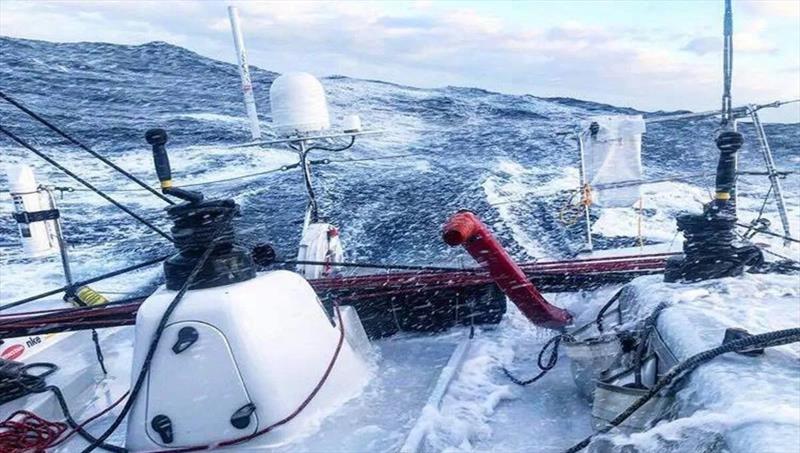
Global Solo Challenge: Carousel of depressions in roaring forties, where extreme becomes ordinary
by Margherita Pelaschier / Global Solo Challenge 22 Dec 2023 01:36 NZDT
21 December 2023

Cole Brauer - First Light © Cole Brauer Ocean Racing
With Andrea Mura on Vento di Sardegna passing the Cape of Good Hope Wednesday afternoon, only two competitors are still in the Atlantic Ocean.
Alessandro Tosetti on Aspra, who is just a few days away from this significant milestone, and Kevin Le Poidevin on Roaring Forty, who has passed the latitude of Recife and is managing his descent into the South Atlantic well with the help of the southeast trade winds. Among the other twelve skippers in the race, only Philippe Delamare, firmly in the lead on Mowgli, has reached the Pacific, while the others are engaged in the difficult crossing of the Indian Ocean.
Ari Kansakoski on ZEROchallenge finally, after a slow start from Cape Town, pushed south to 41 degrees S and regained good speed. Édouard De Keyser on Solarwind chose to cut through the Ice Limit Buffer Zone (allowed by the rules for a maximum of 72 hours) and stay further south at 43 degrees to maintain winds around 15-20 knots and avoid the calm of the anticyclone that will settle in the area after the low pressure system passes. David Linger on Koloa Maoli and William MacBrien on Phoenix stayed further north, at 42 degrees, to get through the strong depression that passed over the Kerguelen Islands. Yesterday morning, the American skipper saw William's Class40 just 20 miles away on his radar. François Gouin on Kawan 3 pushed further south to 46 degrees and gybed on Tuesday night to then sail fast eastward. Louis Robein's Le souffle de la mer III, in the southern seas, has regained good speed and has re-entered the competition with the fleet. The competitors are seeking a balance, adjusting their course by a few degrees north or south to maintain sailing in winds that are not excessively strong, thus avoiding rough and crossed sea conditions. Like Pavlin Nadvorni on Espresso Martini, who stays north of the low pressure systems, now at 44 degrees S, with the clear goal of preserving his boat and avoiding unnecessary damage.
Riccardo Tosetto on Obportus 3, currently in fourth place in the provisional rankings based on the estimated arrival date, is recording good speeds and is chasing third-place Ronnie Simpson aboard Shipyard Brewing, more than 800 miles ahead of him. Cole Brauer, second in the entire fleet on First Light with a superb performance, is now heading towards the second of the great capes, Cape Leeuwin. Philippe Delamare on Mowgli, who became the fleet's leader after the retirement of Dafydd Hughes's Bendigedig in Hobart, is retracing his favorite ocean, the Pacific, which he had previously crossed on a catamaran. The French skipper uses the Buffer Zone to avoid calm areas and ride the depressions in an attempt to maintain a high average speed and not lose his lead.
The demanding route of the GSC challenges skippers to round the three great Capes - Good Hope, Leeuwin, and Horn. The 10,000 miles needed to cross the Indian Ocean, after passing the Cape of Good Hope, and the Pacific, at low latitudes, represent more than a third of the total route. Undoubtedly, they are the worst part in terms of wind and sea conditions of the 25,000 total miles of the journey needed to circumnavigate the globe.
A predominant feature of this area is the constant presence of low pressures coming from the west, forming a sort of carousel that follows in close frequency, even though we are on the doorstep of the austral summer. The strong winds associated with these depressions, not encountering land masses that can attenuate them, gain strength and speed as they advance. They consequently influence the state of the sea, which breaks into large cross waves and breakers. Already in the 19th century, sailors who had navigated the cold and dangerous waters at these latitudes had coined the terms 'Roaring Forties' and 'Furious Fifties', referring to the noise of the wind in the rigging of the boats that became sharper and unbearable, the further south they went.
But how do those large red masses we see on the tracker proceed, dragging with them 40-knot winds and waves of more than 5 meters, which the Italian skipper Andrea Mura jokingly called "that red filth"? Each depression in the southern hemisphere is preceded by northerly winds, rotating counterclockwise towards the northwest. Then comes the passage of the warm front, which is not particularly violent or stormy. The subsequent cold front, however, causes a sudden 90-degree change in wind, bringing with it an unstable mass of cold air from Antarctica. In these conditions, the sea becomes extremely rough, with cross waves, wind gusts, and the possibility of forming breaking waves that have led some competitors to experience knockdowns. To describe the sea state, even the most experienced skippers often use adjectives like 'dantesque' or 'infernal' conditions in their blogs.
Continue reading the full article here...